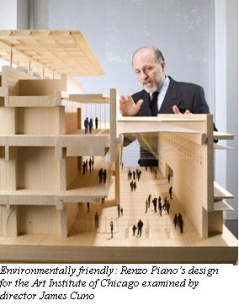
We've all heard the arguments against green technology: it's costly, experimental, unreliable, etc. ... It turns out that one of the last groups of people holding fast to some of these notions are art museum directors. On the one hand, it's understandable: as this article from The Art Newspaper points out, museums do have unique requirements for lighting and climate control: those Botticellis and Monets are pretty sensitive! On the other hand, the Art Institute of Chicago, and even St. Louis' Contemporary Art Museum, are proving that green building techniques can meet the demands of rare and precious works of art. According to writer Charmaine Picard:
The Art Institute of Chicago is perhaps one of the most environmentally sound museums in the country. The institute is seeking a silver certification for its $285m expansion by Renzo Piano, which is now under construction and integrates a range of green features including a photocell lighting system that dims as ambient light gets brighter and a double-window façade that provides natural ventilation and light. Nearly ten years ago, the museum had the foresight to install solar panels on its roof and it recently hired a consulting firm to assess if it can save energy by overhauling its heating, ventilating and air conditioning systems.And that will probably be key for many institutions -- keeping long-term costs down has to be attractive to directors constantly hustling for donations. Once again, we see the power of the pocketbook driving green development. I still tend to think this is a good thing -- in this particular case, these folks live and breathe art, and will do what it takes to preserve that work. If we can show them that they can accomplish that goal for less money by taking green steps (and, perhaps, even create a few sustainable building jobs along the way), we all win...
Some architects such as Renzo Piano are known for using natural lighting and energy-efficient systems having been trained in continental Europe where fuel costs are significantly higher and where energy-related building codes are much stricter than in the US. Since museums require 24-hour humidity and temperature controls, an initial investment in energy-efficient systems could significantly reduce operational costs in the long-term.
Via linton at Hugg
Categories: art, museums, greenbuilding, chicago, stlouis